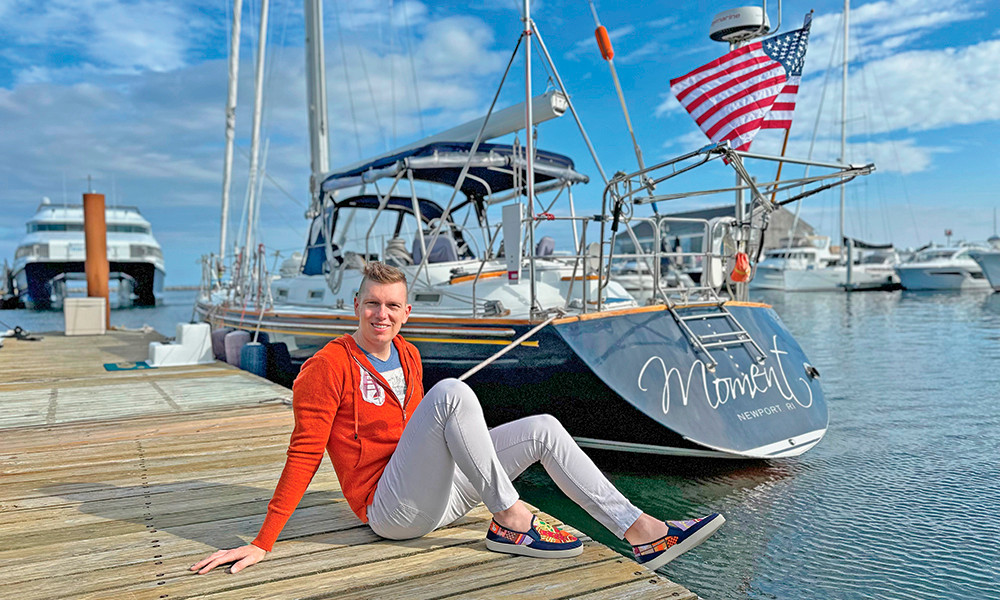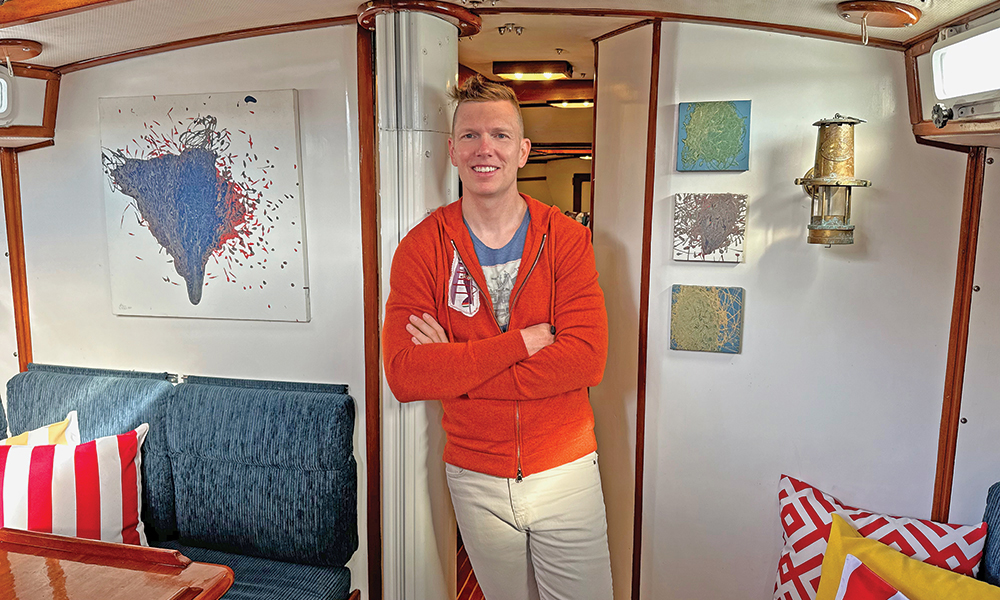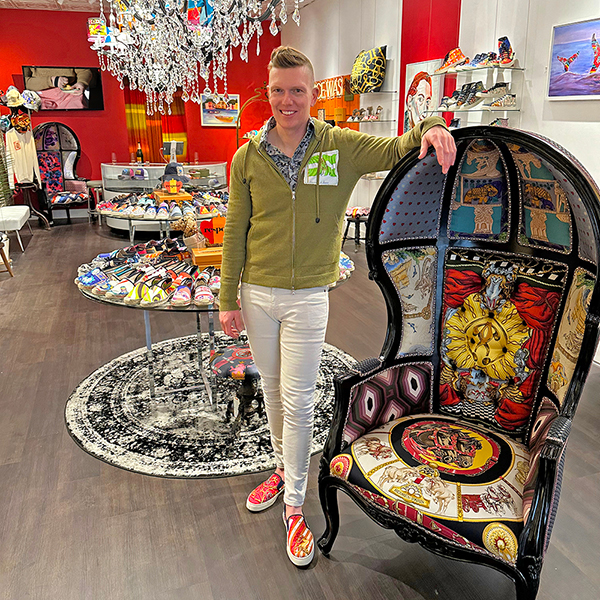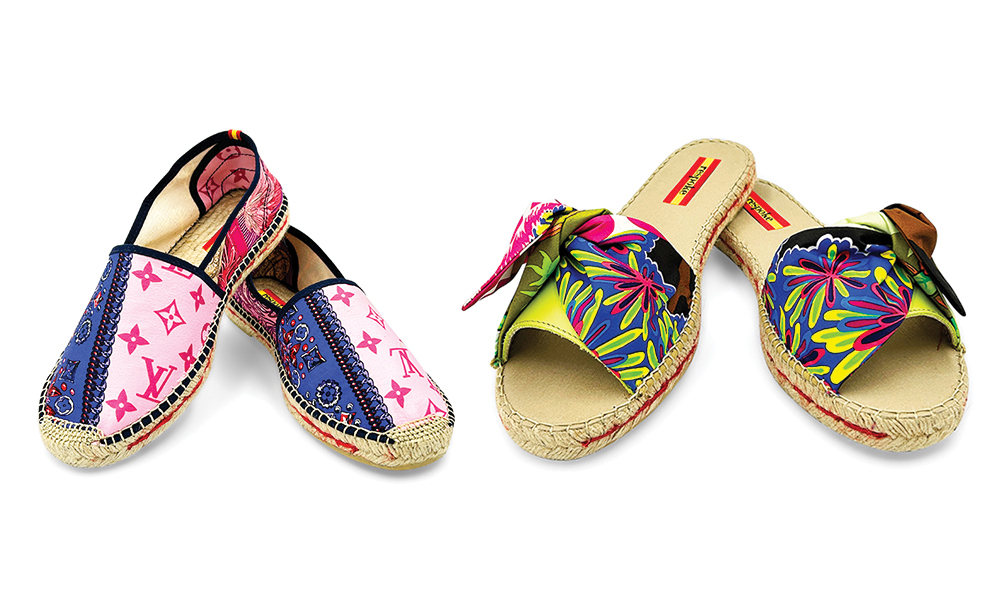From sail to sole, alumnus charts a sustainable fashion course
Using upcycled luxury scarves, Chris Bartick (’05) reimagines the shoe
Featured Stories
SUMMARY: Chris Bartick’s (’05) career is anything but ordinary. As the co-founder of Respoke — a fashion brand transforming iconic designer scarves into one-of-a-kind, handcrafted shoes and apparel — he has built a business where luxury meets sustainability and every product tells a story.

At the northernmost point of Cape Cod, Chris Bartick (’05) embarks from his home in bohemian Provincetown, Massachusetts, aboard a 47-foot sailboat, the 1981 Moment. He steers his ship’s wheel south about 75 miles to Martha’s Vineyard, where it’s just another day in the office.
|
“Delivering luxurious beauty and joy to people is amazing. To be able to showcase a product that holds one-of-a-kind self-expression via a method that’s cleaner and greener than others is pretty empowering.” |
On his wind-powered way to work, the School of Art, Design and Art History graduate slips into his signature boat shoe, a sport loafer made from upcycled authentic Hermès scarves. As the owner of Respoke, a fashion brand that repurposes iconic, luxury designer scarves into unique products, Bartick oversees its five retail locations: four in New England and one in Charleston, South Carolina.

Each of the boutique locations offers a different selection of handcrafted footwear, as each run is extremely limited and individually reveals different parts of each scarf. There will be a bow slide made from Louis Vuitton and Emilio Pucci scarves only available at Martha’s Vineyard, while Nantucket will have the only flip-flops made from Hermès’ difficult-to-find Bolduc scarf. Customers can also purchase ready-to-wear garments, fine art, furniture and accessories transposed with the scarf embellishments.
From vintage to new, Versace to Gucci, Bartick sources the designer scarves from major auction houses and dealers on his annual trip to Europe. “All are vetted and authenticated at the end of the day,” he said.
A self-described “art kid,” Bartick says his cohesive, reimagined designs are instantly familiar to consumers. “When people walk in the stores or see me outside with the shoes, their eyes light up, and they’re like, ‘What is this?’ Because they recognize the prints, but they’re all one of a kind,” said Bartick, who earned a Bachelor of Fine Arts in Graphic Design.
|
“One really cool part of our process is the anthropology element. We don’t have a factory. We have a network of people who have been doing their portion of the shoemaking process passed down through multiple generations of their families.” |
Before establishing Respoke’s flagship store in Charleston, Bartick initially launched a sample run of shoes in 2018. “Our first feather in our hat was getting them in Bergdorf Goodman. Linda Fargo, the creative director, fell in love with them,” he said. Neiman Marcus and Bloomingdale’s have also carried Respoke as well as department stores overseas in Abu Dhabi and Hong Kong.
Next year, Bartick celebrates the 10-year anniversary of the brand and says he’s excited to expand operations, hoping to open stores in Florida, Texas and New York City. “We’re very summer heavy. To have year-round stores,” he said, “it’s better for business.” He also recently hired Media Arts and Design major Drew Kevitch (’20), with an Interactive Design concentration, to manage Respoke’s social media and marketing.

In an industry of fast fashion, Bartick pushes his company in a direction that’s as sustainable as possible. “What we’re doing at Respoke is taking something that’s already in existence and meshing it up with natural products. Even our sneakers are made of vulcanized rubber from the rubber tree.” And the foam insoles come from corn.
Building on Respoke’s mission of upcycling for good, Bartick recently released a more affordable sub-brand called Re by Respoke. He uses recycled plastic bottles for the shoes’ pin-striped, upper fabric “to keep plastic out of the ocean’s waters and landfills.”
Respoke’s espadrilles are produced in the rolling, wine-flowing hills of La Rioja, Spain — the birthplace of the espadrille shoe. “One really cool part of our process is the anthropology element,” Bartick explained. “We don’t have a factory. We have a network of people who have been doing their portion of the shoemaking process passed down through multiple generations of their families.”
For the first step in creating the Respoke espadrille, local artisans wind jute fiber together using custom-made machines to create the basic shoe form. Then they sew the outsole together with the jute rope and thread.
Several family-owned workshops in the idyllic mountain region contribute to the craftsmanship of the espadrille. “I’ve gone there and met them. It’s so beautiful — you can’t replicate that,” Bartick said.

When it’s time for the final touch, “there are very few people who can do it in the world,” Bartick said. Perhaps sitting on a deck overlooking the valley or on a stoop chatting to a friend, an experienced artisan sews the classic, hand-stitched webbing to the tip of the espadrille, known as the toe piece. Nowadays, most espadrilles with a toe piece are factory-made.
“We’re maintaining this community and skillset … just by presenting these shoes and giving [artisans] the work and fair wage. It’s preservation of tradition.”
“Delivering luxurious beauty and joy to people is amazing,” Bartick said. “To be able to showcase a product that holds one-of-a-kind self-expression via a method that’s cleaner and greener than others is pretty empowering.”
